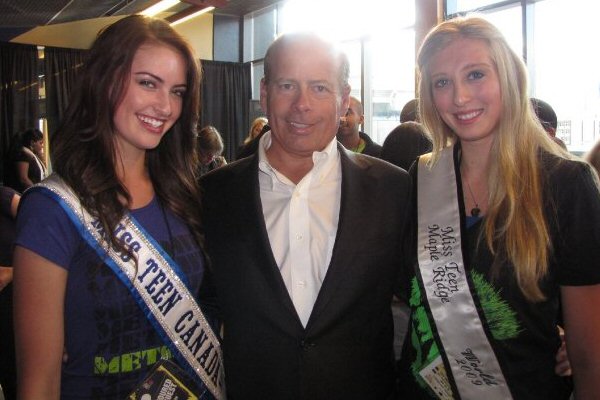 Hello, its Katelynne, Miss Teenage Canada 2018. I am excited to talk about my most recent project. Although I have been very busy with school, travel between Toronto and Winnipeg, and other projects on the go, I have also decided to tackle another project, which has become dear to my heart that also aligns with the Miss Teenage Canada organization (MTC) objectives.
Hello, its Katelynne, Miss Teenage Canada 2018. I am excited to talk about my most recent project. Although I have been very busy with school, travel between Toronto and Winnipeg, and other projects on the go, I have also decided to tackle another project, which has become dear to my heart that also aligns with the Miss Teenage Canada organization (MTC) objectives.
Those of you that have been following my journey, or the journey of any Miss Teenage Canada delegate, know that MTC is committed to giving back to the community. Each year, Miss Teenage Canada is proud to support different charities across Canada. Funds raised by the MTC delegates at the National Pageant each year support the WE Charity, formerly known as Free the Children. The WE organization vision is a world where all children have access to education and where no child has to work to ensure their family’s survival. The WE model, WE villages “is an international development model that addresses the five primary causes of poverty with holistic and sustainable solutions that work in tandem to transform communities”(https://www.we.org/we-villages/our-development-model/).
WE Villages have five pillars, each one a critical component to breaking the cycle of poverty: education, health, food, opportunity, and water.
Why is water a one of the five pillars? As referenced by the WE organization, children, especially girls, can only attend school if they have access to clean water. Having access to clean water prevents the need to collect water on a daily basis, which allows children to attend school, prevents waterborne illness, and helps a community become self-sustaining.
Leonardo da Vinci described water as “the driving force of nature.” Clean water is not a luxury, it is a necessity. Given the importance of this resource, and the potential devastating impacts from its scarcity, I have embarked on a journey to further educate myself on water facts and issues. Although I have always been concerned about water pollution, wastage, and accessibility, I had not personally focused on raising awareness. I am hopeful that by partnering with organizations that are committed to addressing water related issues, that I can raise awareness that will make a difference.
With this in mind I have recently contacted various organizations whose objectives are focused on water conservation, bringing awareness regarding the global need for clean water and other water related issues. I am pleased to acknowledge that I am working with Water Ambassadors of Canada (WAC).
WAC’s mission is “to respond to the global need for clean water and reach some of the most remote communities in developing countries” and their vision is a “world where every individual has easy access to clean, safe water and practices good hygiene to prevent the transmission of disease.” WAC is a faith-based, non-profit organization committed to providing clean, safe drinking water to desperately poor people in developing countries. Through partnering with in-country organizations, WAC sends teams on 7-10 day water mission trips to build and repair wells, install water filtration and chlorination systems, construct bio-sand filters, and teach health and hygiene. WAC has successfully completed many of these projects and has had a significant impact in many communities.
Needless to say, I am excited to participate in WAC’s Scotia Charity Challenge on Sunday Oct. 21, 2018. A group from WAC along with me will be participating in the 5km walk on October 21st with signs and buckets (sometimes with buckets on our heads). One might ask why we will be carrying buckets on our heads? Well, did you know that the average distance that women and children in developing countries often need to walk on a daily basis to get their water is usually around 6 km. Not only do women and children in these poor communities endure this long trek, but the water is often dirty and contaminated. WAC participates in this event every year in order to raise awareness of this global water crisis. It is such a privilege to be able to work with WAC to help promote the global need for safe drinking water.
So why walk for water? Well, did you know that contaminated drinking water is the largest cause of death and disease in the world? Millions of people around the world do not live near a clean water source, exposing them to illness and disease. As referenced by both the WE organization and the Water Ambassadors of Canada organization on their websites, improving access to clean water is one of the most crucial and quickest ways to raise a community out of poverty. WE can help improve lives by improving access to clean water.
If you are in Toronto on October 21st, I encourage you to come out and participate in the Walk for Water along with me and representatives from WAC. Please follow this link for more information on the event. https://www.waterambassadorscanada.org/walkforwater.html
If you cannot make the event, there are other ways you can get involved. I encourage you to visit the Water Ambassador of Canada website at https://www.waterambassadorscanada.org/ to learn more about what this organization does and to learn how you can get involved. Below are a few links to guide you:
- Donate: Did you know that a $25 donation can provide 5 people with clean water. Any one time donation amount has an impact. Please follow the link to make a donation: https://www.waterambassadorscanada.org/donate.php
- The H20 Project: In 2001, a group in the United States launched the H20 project to raise awareness and monies for the global water crisis. The idea is to set aside your usual beverage purchases such as coffee and lattes, sodas, juices, and any other drinks you ordinarily consume for two weeks and replace these drinks with water. Calculate your savings over these two weeks and send that amount to a charity whose objectives include providing clean water to communities in need (please consider WAC) – Challenge your family and friends to do the same! If you cannot commit to two weeks, challenge everyone at your place of work to go without their favorite beverage even for a shorter period of time! You may be surprised how quickly this can add up. Ever bit makes a difference.
- Support A Team: WAC send teams on short-term water mission trips every year, primarily in the Caribbean and Central America. Follow the link https://www.waterambassadorscanada.org/trips.php#upcoming to find out more about upcoming trips and https://www.waterambassadorscanada.org/get_involved.html to find out several different ways you can get involved.
As referenced above, providing clean water to villages is the most effective way to relieve poverty. I encourage you to follow the links above to help the Water Ambassadors of Canada, or WE organization or another organization in your community contribute to this objective! WE can make a difference together!
GENERAL FACTS:
- Only .007% of water on earth is available for drinking.
- ~1.1 billion people (~1/6th of the world’s population) lack access to clean water.
- ~2.4 billion people (~40% of the world’s population) lack adequate sanitation (toilets).
- 80% of illnesses in developing countries are linked to poor water and sanitation.
- ~1.5 billion people suffer from illness due to water-borne parasites such as worms, protozoa and bacteria.
- ~6000 children die every day from the illness caused by water-borne diseases
- ~600,000 children annually die from illness like diarrhea resulting from unclean water
- The lack of clean water can retard the growth of a child by up to 15%.
- 30,000 people die every day because they have to drink bad water. The horrible Boxing Day Tsunami in 2004 resulted in 300,000 deaths.
- ~ 50% of all the hospital beds around the world are occupied by patients suffering from water-borne disease.
- 80% of all disease and sickness in the world is caused by inadequate water supply or inadequate sanitation.
- In the developing countries women and children walk an average of 4 miles (6 km) daily to get water (which is often contaminated) and then must carry a 40 lb container of water once full. This trek is not only enduring but is time consuming, preventing attendance at school or work and the trek can result in spinal deformities and expose women to assault.
Come join me on October 21st for the 2018 Scotiabank Toronto Waterfront Marathon.
Join me – https://raceroster.com/events/2018/14593/2018-scotiabank-toronto-waterfront-marathon
Date: Sunday October 21st, 2018
Start time: 8:00 a.m.







